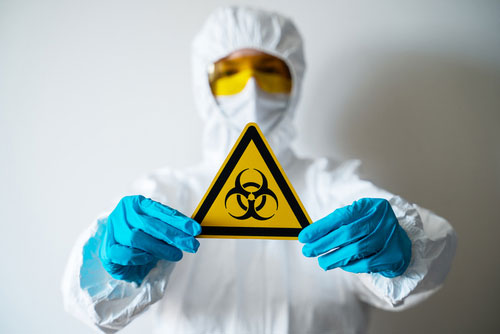Written by Occupli Safety Consultant Jake Bumpus
The Safety, Health and Welfare at Work (Biological Agents) Regulations defines a “biological agent” as “micro-organisms, including those which have been genetically modified, cell cultures and human endoparasites, which may be able to provoke any infection, allergy or toxicity…”.
Biological agents are classified into 4 risk groups according to their level of risk of infection. A group 3 biological agent is one which can “can cause severe human disease and presents a serious hazard to employees and that may present a risk of spreading to the community, though there is usually effective prophylaxis or treatment available”.
In the event of a spillage or leak of a group 3 biological agent, there is a clearly a potential risk of harm to staff, but also to others present in the facility, and the wider community.
In a facility which has already implemented good biohazard management practices, then in the event of a spillage of a group 3 biological agent there will already be control measures in place to minimise the consequences of such an event. These measures correspond with Containment Level 3 (CL3) in the Code of Practice. For example:
- Access to and from the area where the biological material is being handled will be controlled, and will be via doors which are self-closing and lockable.
- Access to this area will only be for authorised personnel who are suitably competent to work with pathogens (including spill response training).
- These personnel will wear suitable PPE which they will don in a dedicated gowning up area before entering the area, and they will have received any necessary vaccinations.
- The area will be maintained at a negative air pressure compared to surrounding areas, to prevent aerosol migration into other areas.
- Air which is extracted from the area will be filtered by HEPA filtration before release to the environment.
- Surfaces in the area will be impervious to water and easy to clean with disinfectants.
In regard to the procedure for dealing with a spillage of a biological agent, the following actions should occur:
- The area with the spillage should be blocked off, and personnel should call for assistance from the Emergency Services.
- Personnel dealing with the spillage should wear the appropriate PPE while doing so.
- Absorbent materials should be placed on and around the spill.
- An appropriate disinfectant (depending on the material, could be a bleach solution) around the spill working inwards.
- The disinfectant should be left for an appropriate contact time (at least 10 minutes)
- The spill materials should be carefully retrieved and placed in the appropriate waste containers.
- The area should be wiped with disinfectant and finish with a water rinse if necessary.
Following the incident, the relevant risk assessment should also be reviewed and updated if required.
Occupli Consultancy is a leading provider of professional services for biosafety in the workplace, including biosafety consultancy and biosafety awareness training.
Under the Safety, Health and Welfare at Work (Biological Agents) Regulations it is the duty of every employer to assess the risks arising from the use or presence of biological agents in the workplace and in determining adequate precautions or control measures to safeguard health and safety.
Similar Topics:

